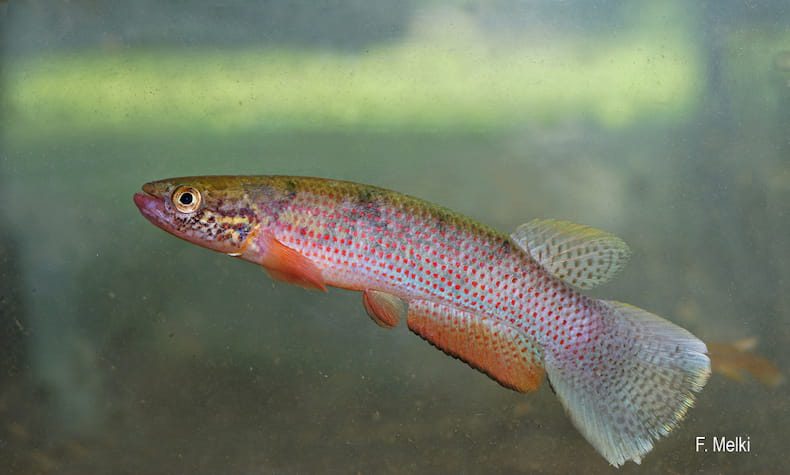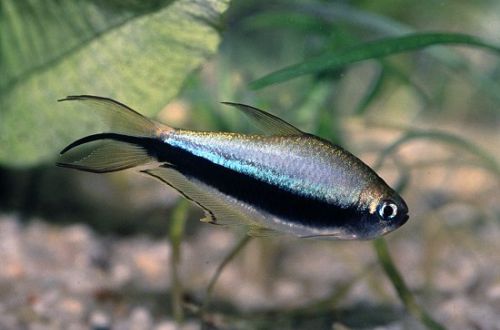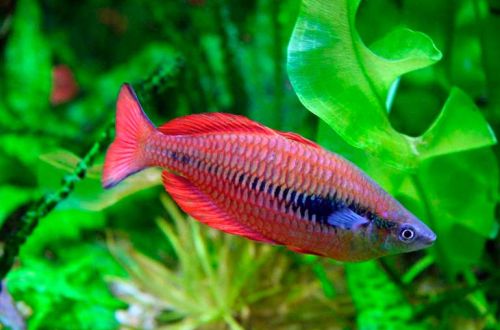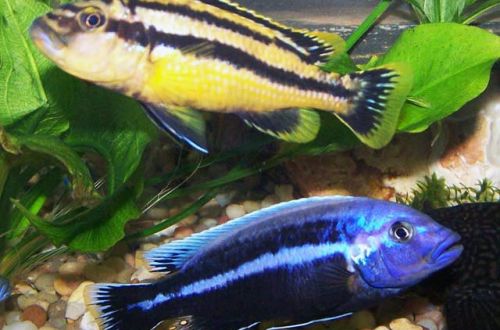
Rivulus igneus
Rivulus igneus, scientific name Anablepsoides igneus, belongs to the family Rivulidae (Rivulus). The fish is native to South America. Inhabits the basin of the Oyapok River, located in the northeast of the continent. The river is the natural border between French Guiana and the Brazilian state of Apama.

In the wild, adult fish are found in slow-flowing sections of the river. Prefers regions with soil covered with a layer of fallen leaves, various branches and snags. Fry are found in small backwaters with stagnant water. Sometimes they find themselves in isolated water bodies during the dry season.
Description
Males grow up to 15 cm. Females are noticeably smaller – about 9 cm. The fish has an elongated body with large dorsal and anal fins, which are shifted closer to the tail. The body color is gray-blue with a pattern of numerous red specks, evenly distributed over the body and forming horizontal dotted rows.

Unlike many related species, this Killie fish tends to live for more than one season and lives in river systems rather than temporary pools.
Behavior and Compatibility
It is considered a territorial species that protects its site from the encroachment of other fish. At the same time, Rivulus igneus can live in a group of relatives, forming a strict hierarchy, in which the dominant individual takes the best place, and the rest are at a distance.
Species aquarium is recommended. It does not get along well with fish of comparable size. At the same time, larger species will feel quite comfortable in the company of Rivulus, which cannot be said about the latter.
Brief information:
- The volume of the aquarium – from 150 liters.
- Temperature – 22-28°C
- Value pH — 6.0–7.5
- Water hardness – soft or medium hard (4-15 GH)
- Substrate type – dark soft
- Lighting – subdued
- Brackish water – no
- Water movement – little or no
- The size of the fish is up to 15 cm.
- Food – live or frozen food
- Temperament – inhospitable
- Keeping in a group with several males and females
Keeping and breeding in an aquarium
It is considered a difficult species to keep for beginner aquarists. In addition to the difficulty in choosing compatible species, maintaining stable water parameters is a challenge. It is necessary to prevent sharp and significant fluctuations in pH and GH, as well as to saturate the water with tannins.
In nature, tannins are released during the decomposition of plant organic matter (leaves, branches, driftwood, etc.). In an aquarium, it is permissible to use special suspensions or place them in natural leaves, bark and cones of some trees (oak, alder, etc.).
Breeding in an aquarium is possible. Under favorable conditions, females lay up to 100 fairly large eggs about 3 mm in size. The incubation period lasts about 2-3 weeks.
However, depending on external conditions, diapause may occur, for example, during a prolonged drought, shallowing of a reservoir, etc. During this period, the development of eggs stops and they go into a kind of waiting mode, which lasts up to 3 months. In aquariums, as a rule, diapause does not occur.
Sources: FishBase





